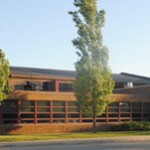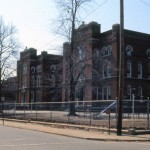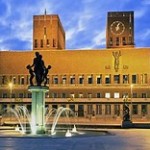My Musical Career | Part Twenty-Two
Evansville Years Concluded – Transitioning to Oslo
Up until this point, the Evansville/Owensboro years were the happiest and most productive of both my musical and personal life. Musical because of the repertoire I was introduced to and the experience I gained both as a performer and teacher, and personal because it was here that I brought my bride and started my family. The people in Evansville could not have been more warm and encouraging, and we still have many friends in Evansville after all these years. The one aspect I have not given too much attention to in this blog is the artist-in-residence portion of my position. The reason for that is that it was not really part of the consortium, but sort of added on due to the persistence and vision of Mrs. Beeson and members of the artistic community, who wrote and were granted funds for this undertaking. It was renewed for only one more season – my second, and then, although there was talk of trying for a third season, there was less support for it the third time around, and there was no grant for my third and last season.
Basically, what I did for the spring of 1981 was to work with the students and faculty at Plaza Park Elementary School and integrate music into the general education curriculum. For example, for the science portion of the curriculum, I talked about sound waves and related them to the percussion instruments; in the art class, I talked about how a timpanist was like a painter in that he could produce light and dark tones with his instruments and sticks to make a sound picture much as the painter used his color palette to create a visual picture. I also worked with the school’s aspiring percussionists in preparing them to play two simple percussion ensemble pieces for the music night which was the culmination of the project. I worked with the kindergarten through third grade classes – teaching them simple rhythms and to make simple percussion instruments – rattles – oatmeal box drums, etc. and put together pieces for them so that each class could participate in music night. The kids seemed to eat it right up. I worked out of a small office in the back of the school – I was on campus three days a week, and I really enjoyed working with them. Another and major part of this assignment was to bring guest artists to the school to perform at special assemblies. I myself did an introductory assembly at the beginning of the project, then proceeded to invite the U of E Brass Quintet and Dr. Dennis Shephard’s Savoyards to the school for two eagerly anticipated and memorable assemblies. Music Night – the project’s culmination occurred just before the end of the school year – a special night was selected – the students trained and prepared – invitations sent to parents – and then it was time for the show. It began with grades K -3 doing their little percussion pieces, followed by the fourth and fifth grade percussionists doing their percussion ensemble pieces. They all did marvelously! I concluded the show with a mini-recital.
As I had mentioned earlier, all this took place in the spring semester of 1981. The program was adjudged a success, and immediately the members of the committee applied for a grant for the next season. It was granted, with the following proviso: This next grant was to be used at an inner-city school. The school chosen was Culver Elementary
Transition to Oslo – And a tornado to boot!
All of these activities, orchestra, teaching, and artist-in-residence, took place over a nearly three-year period, starting in September of 1980, and ending in July – August 1983. The artist-in residency portion lasted only two full semesters, from spring 1981 until fall of that same year. The prospect of a third year, this time without the income from the artist in residence position was not a thrilling one, especially when one was starting a family. It forced me to think out my future, and while we loved our friends and colleagues in Evansville, clearly there was a need for us to go wherever there was opportunity for me to pursue my career. At this stage, I was still employed during the summer at the Lake George Opera Festival, and it was in early June of 1982, just before I was to head east for the opera season that I received word from my teacher and mentor, Fred Hinger, that the timpanist’s
position with the Oslo Philharmonic in Oslo, Norway was open. According to his colleague at the Met, Per Brevig, who was principal trombone of the Met at the time (and was from Norway), the orchestra had held auditions and had not chosen anyone. The chief conductor, Mariss Jansons, was looking outside and they would offer any candidates whose resume met their criteria a trial period with the orchestra. He advised me to get my resume in as soon as possible – but to first to check with Per Brevig as to details. I did so, and Mr. Brevig told me about conditions there, and that it would be a good position to have and that that Oslo was a good community to live in as well as work. I immediately sent my resume in and went about my business for the next two months, which included the opera season and living through a tornado which roared up the Ohio River in mid-June. I had just returned from doing some work at my office, and sat down to a lunch of tomato soup and grilled-cheese sandwich, and my wife and I were listening to the radio as the weather looked ominous. I noticed this as I drove to our apartment, which was not far from the river. The clouds were almost black. I made mention of this to my wife, and as I was about half-way through lunch, we were told to “take cover”. We ran downstairs and stood under a strong door-frame. We could see outside – the rain was horizontal – the wind was over 90 miles and hour – and bits of trees flew past the window. The storm lasted about ten minutes, and we were fortunate. The house we were in was not hit, but trees were uprooted, our neighbor’s truck was destroyed by a falling tree, and lamp standards were crumpled. We were without electricity for about three days, although mercifully we had a gas stove and heat, so we had hot water, so we were able to eat and wash. We used kerosene lamps to read at night, although those were pretty dim, so it was usually an early night for us. Mercifully, after three days we had power restored and were able to resume our regular activities. Our car was not affected, and we drove around the city and were surprised at the extent of the damage – much of the city was affected, especially the areas nearest the river. The Invitation The invitation from the Oslo Philharmonic came via a phone call from the orchestra on Labor Day, 1982. I had by then performed by duties at the Lake George Opera Festival and had returned and was planning the fall semester at U of E. I actually was in bed with a twenty-four hour virus and was completely spent when the call came. It was a Mr. Terje Mikkelsen, who at that time was the orchestra’s operations manager. He was calling to let me know (in excellent English) that they had gotten my resume and had been recommended by Mr. Hinger. They were prepared to offer me a ten-week trial period with the orchestra from the end of November 1982 until mid – February 1983. Was I prepared to accept? Was I? I accepted immediately, and my wife and I spent the rest of the day planning for how this was to be accomplished. My twenty-four hour bug disappeared fairly quickly as we discussed the implications of the offer, and I was back on my feet the next day. I spent the next week or two informing my employers of the situation and arranging to get the necessary leave if possible. I have to say the orchestras and university were most generous, and I was able to contact my friend David Davenport, who was then with the University of Kentucky at Lexington to fill in for me for the period of December 1982 through March 1, 1983 with the orchestras and U of E. I would then return to my positions on that date. As things turned out, it was a most eventful trial period. I’ll leave those details to the next installment.



Recent Comments